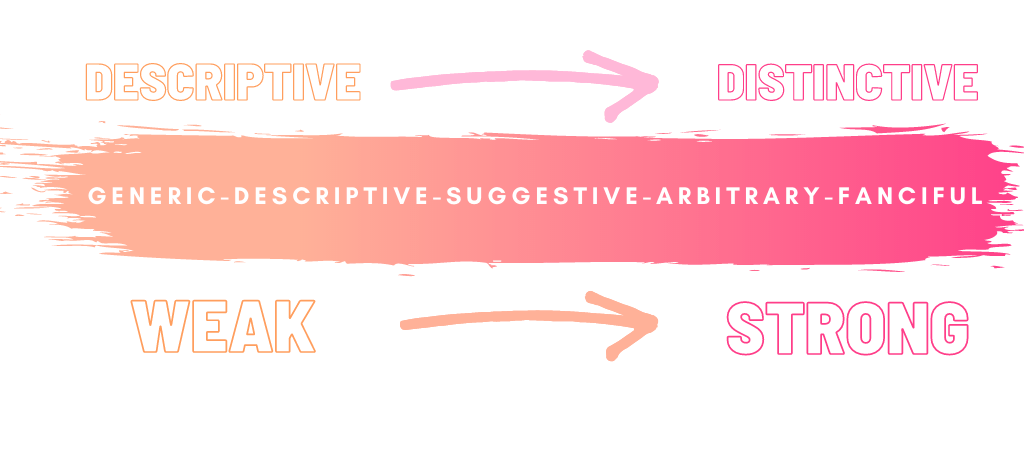It is the new year and a lot of us resolved to work out more and get stronger. But don’t limit your strength training to just your muscles–your trademarks deserve a little boost as well!?
Why is trademark strength important?
U.S. trademark law recognizes a spectrum of distinctiveness that provides a sliding scale of trademark protectability. Judge Pierre Leval defined trademark strength as the amount of “legal muscle” possessed by a given mark.
The stronger the mark, the more uses the trademark owner may exclude from the marketplace through a trademark infringement or dilution action. Stronger marks are able to exclude more similar marks from the marketplace. Such increases can happen along two fronts: “appearance” of the trademark and the “goods or services” the trademark protects. The stronger a registered trademark is on the “appearance” dimension, the less similar the look, sound, and spelling a third-party’s mark must be in order to risk being excluded by the registered trademark. The stronger a registered trademark is on the “goods or services” dimension, the less similar the goods or services offered by a competitor using the same or similar marks must be in order to risk being excluded by the registered trademark.
A trademark’s relative strength or weakness will also have a direct bearing on its performance in the market. A mark that is highly distinctive functions as a strong mark, identifying the owner as the source of the covered products or services. When a mark is not distinctive or it may already be used by others on or in connection with different products or services, the mark is considered weak.
Therefore, trademark strength is extremely important for trademark owners as it has a strong impact on the value of the trademarks to their owners. It is generally easier and less costly for a trademark owner to acquire and enforce exclusive rights in a strong trademark that is distinctive and unique than one that is descriptive or highly diluted, i.e., widely used.
How is a mark’s strength or weakness gauged?
The relative strength or weakness of a trademark may be gauged by placing the trademark on a spectrum. The types of trademarks discussed below range from the strongest to the weakest.
- Fanciful or Coined Marks. A fanciful or coined mark is at the strongest end of the spectrum because it is inherently distinctive. Such a mark consists of an invented word that is a combination of letters that has no meaning. For example: GOOGLE for online services, PEPSI for soft drinks, ROLEX for watches, and XEROX for copiers. Since a fanciful or coined mark has no inherent meaning, in the beginning, a bigger effort in terms of advertising is necessary in order to educate the public as to the relationship between the invented word and the owner’s product or service. However, these marks enjoy the broadest scope of protection against third-party use.
- Arbitrary Marks. An arbitrary mark is composed of a word or words that have a common meaning in the language of the relevant jurisdiction; however, that meaning is unrelated to the goods or services for which the mark is used. Arbitrary marks, such as CAMEL for cigarettes and APPLE for computers, are considered highly distinctive in identifying and distinguishing products or services. As with fanciful or coined marks, the public must be educated as to the association of the arbitrary mark with the relevant product or service, but the scope of protection obtained is very broad.
- Suggestive Marks. A suggestive mark gives consumers some sense of the nature of the products or services that a business will provide without actually describing the product or service. A suggestive mark is one that requires “a mental leap from the mark to the product”, or, “the consumer’s imagination, thought, and perception to reach a conclusion as to the nature of the goods or services.” Variety Stores, Inc. v. Wal-Mart Stores, Inc., 888 F.3d 651, 662 (4th Cir. 2018). Examples of suggestive marks are AIRBUS for airplanes and NETFLIX for streaming services. Suggestive marks can possess an inherent element of sales appeal and will require less education of the public than coined or arbitrary marks; for this reason, generally, suggestive marks are entitled to less-extensive protection.
- Descriptive Marks. In general, a descriptive mark is a word (or words) that merely describes a product or that contains ingredients or attributes that are too weak to function as a trademark. An example of a merely descriptive mark would be COLD AND CREAMY for ice cream. Such a mark is very unlikely to be granted registration, as the phrase merely describes an attribute of the product. Words that merely describe an attribute, feature, end result, or use of the product, or the persons employed in its production, generally are not granted trademark protection. Merely laudatory terms such as “best” or “quality” also are generally not registrable. In some jurisdictions, surnames are treated as descriptive marks. What is initially a descriptive word may later become protectable as a trademark if it acquires secondary meaning. In other words, if a descriptive word is used and advertised exclusively as a trademark for a sufficient period of time, it may, in addition to having the primary meaning that is descriptive of the product, come to identify the mark as being associated with a single source of origin for that product. An example of a descriptive word that has acquired a secondary meaning and become protectable as a trademark is SHARP for televisions.
- Generic Words. A generic word can be thought of as the common name of the product or service in question—for example, “clock” is a generic word for timepieces. Such words can never be appropriated by a single party as trademarks for the products or services they signify, since the public perceives and uses them solely as common nouns or terms. Generic words or phrases are not registrable or protectable in relation to the products or services they signify.
How to select a strong trademark?
As a trademark applicant, you should try your best to come up with a strong new trademark that is inherently distinctive. The strongest types of trademarks are (1) fanciful or coined marks, such as EXXON for petroleum products, KODAK for photography company; and (2) arbitrary marks, such as AMAZON for retail services, APPLE for computers, SHELL for gasoline, and BLACKBERRY for cell phones.
There are many resources online that can help you with the naming process of your brand. For example, what we found on this website: https://guide.onym.co/ or the books like “Brand Thinking and Other Noble Pursuits.” Check out our other blog post on how to choose a business name here.
If you need help with determining your proposed trademark’s strength, contact us today to discuss your trademark protection strategies with an experienced trademark attorney. Schedule an appointment with us to schedule a free initial consultation!





